Detection of Green Asparagus Using Improved Mask R-CNN for Automatic Harvesting
Abstract
1. Introduction
2. Related Work
3. The DA-MASK RCNN Model
3.1. Backbone Network
3.2. Improved Region Proposal Network Based on Depth Filter
3.3. ROI Align
3.4. Detection Head
3.5. Loss Function
4. Test Setup for Asparagus Detection
4.1. Test Platform
4.2. Data Acquisition and Processing
4.3. Model Training Strategy
- Train the backbone network and the three-branch network with the initial learning rate.
- Train the overall network at 80 epochs with the initial learning rate and draw the epoch-loss-F1-score figure.
- Select the appropriate epoch value through the figure.
4.4. Model Evaluation Metrics
5. Experimental Results and Analysis
5.1. Experiments for Asparagus Detection
5.2. Comparison with the State-of-the-Art Algorithms
5.3. Ablation Experiments
5.4. Accuracy at Different Depths
5.5. Experiments for Asparagus Harvesting
5.6. Performance of the Proposed Model during the Training Process
5.7. Discussion
6. Conclusions
Author Contributions
Funding
Institutional Review Board Statement
Informed Consent Statement
Data Availability Statement
Conflicts of Interest
References
- Boonsiriwit, A.; Lee, M.; Kim, M.; Itkor, P.; Lee, Y.S. Exogenous Melatonin Reduces Lignification and Retains Quality of Green Asparagus (Asparagus officinalis L.). Foods 2021, 10, 2111. [Google Scholar] [CrossRef] [PubMed]
- Lu, Z.; Qi, L.; Zhang, H.; Wan, J.; Zhou, J. Image Segmentation of UAV Fruit Tree Canopy in a Natural Illumination Environment. Agriculture 2022, 12, 1039. [Google Scholar] [CrossRef]
- Wei, M.; Wang, H.; Zhang, Y.; Li, Q.; Du, X.; Shi, G.; Ren, Y. Investigating the Potential of Sentinel-2 MSI in Early Crop Identification in Northeast China. Remote Sens. 2022, 14, 1928. [Google Scholar] [CrossRef]
- Xu, X.; Zhao, M.; Shi, P.; Ren, R.; He, X.; Wei, X.; Yang, H. Crack Detection and Comparison Study Based on Faster R-CNN and Mask R-CNN. Sensors 2022, 22, 1215. [Google Scholar] [CrossRef] [PubMed]
- Salam, A.; Javaid, Q.; Ahmad, M. Bio-inspired cluster–based optimal target identification using multiple unmanned aerial vehicles in smart precision agriculture. Int. J. Distrib. Sens. Netw. 2021, 17, 15501477211034071. [Google Scholar] [CrossRef]
- Alam, M.; Alam, M.S.; Roman, M.; Tufail, M.; Khan, M.U.; Khan, M.T. Real-time machine-learning based crop/weed detection and classification for variable-rate spraying in precision agriculture. In Proceedings of the 2020 7th International Conference on Electrical and Electronics Engineering (ICEEE), Antalya, Turkey, 14–16 April 2020; pp. 273–280. [Google Scholar]
- Mamat, N.; Othman, M.F.; Abdoulghafor, R.; Belhaouari, S.B.; Mamat, N.; Mohd Hussein, S.F. Advanced Technology in Agriculture Industry by Implementing Image Annotation Technique and Deep Learning Approach: A Review. Agriculture 2022, 12, 1033. [Google Scholar] [CrossRef]
- Chen, J.; Qiang, H.; Wu, J.; Xu, G.; Wang, Z. Navigation path extraction for greenhouse cucumber-picking robots using the prediction-point Hough transform. Comput. Electron. Agric. 2021, 180, 105911. [Google Scholar] [CrossRef]
- Gupta, H.; Pahuja, R. Estimating morphological features of plant growth using machine vision. Int. J. Agric. Environ. Inf. Syst. 2019, 10, 30–53. [Google Scholar] [CrossRef]
- Arjun, A.D.; Chakraborty, S.K.; Mahanti, N.K.; Kotwaliwale, N. Non-destructive assessment of quality parameters of white button mushrooms (Agaricus bisporus) using image processing techniques. J. Food Sci. Technol. 2022, 59, 2047–2059. [Google Scholar] [CrossRef]
- Sharma, R.; Kumar, M.; Alam, M.S. Image processing techniques to estimate weight and morphological parameters for selected wheat refractions. Sci. Rep. 2021, 11, 20953. [Google Scholar] [CrossRef]
- Fan, P.; Lang, G.; Yan, B.; Lei, X.; Guo, P.; Liu, Z.; Yang, F. A method of segmenting apples based on gray-centered RGB color space. Remote Sens. 2021, 13, 1211. [Google Scholar] [CrossRef]
- Liu, T.H.; Ehsani, R.; Toudeshki, A.; Zou, X.J.; Wang, H.J. Identifying immature and mature pomelo fruits in trees by elliptical model fitting in the Cr–Cb color space. Precis. Agric. 2019, 20, 138–156. [Google Scholar] [CrossRef]
- Unay, D. Deep learning based automatic grading of bi-colored apples using multispectral images. Multimed. Tools Appl. 2022, 81, 38237–38252. [Google Scholar] [CrossRef]
- Zheng, B.; Sun, G.; Meng, Z.; Nan, R. Vegetable Size Measurement Based on Stereo Camera and Keypoints Detection. Sensors 2022, 22, 1617. [Google Scholar] [CrossRef]
- Lv, J.; Xu, H.; Xu, L.; Zou, L.; Rong, H.; Yang, B.; Niu, L.; Ma, Z. Recognition of fruits and vegetables with similar-color background in natural environment: A survey. J. Field Robot. 2022, 39, 888–904. [Google Scholar] [CrossRef]
- Gaikwad, S.; Tidke, S. Multi-Spectral Imaging for Fruits and Vegetables. Int. J. Adv. Comput. Sci. Appl. 2022, 13, 743–760. [Google Scholar] [CrossRef]
- Gai, J.; Tang, L.; Steward, B.L. Automated crop plant detection based on the fusion of color and depth images for robotic weed control. J. Field Robot. 2020, 37, 35–52. [Google Scholar] [CrossRef]
- Kang, H.; Zhou, H.; Wang, X.; Chen, C. Real-time fruit recognition and grasping estimation for robotic apple harvesting. Sensors 2020, 20, 5670. [Google Scholar] [CrossRef]
- Yang, M.; Cho, S.I. High-Resolution 3D Crop Reconstruction and Automatic Analysis of Phenotyping Index Using Machine Learning. Agriculture 2021, 11, 1010. [Google Scholar] [CrossRef]
- Zhao, G.; Cai, W.; Wang, Z.; Wu, H.; Peng, Y.; Cheng, L. Phenotypic parameters estimation of plants using deep learning-based 3-D reconstruction from single RGB image. IEEE Geosci. Remote Sens. Lett. 2022, 19, 1–5. [Google Scholar] [CrossRef]
- Silva, D.Q.; Aguiar, A.S.; Santos, F.N.; Armando, J.S.; Danilo, R.; Marcella, B.; Giorgia, B.; Marco, D. Measuring Canopy Geometric Structure Using Optical Sensors Mounted on Terrestrial Vehicles: A Case Study in Vineyards. Agriculture 2021, 11, 208. [Google Scholar] [CrossRef]
- Schima, R.; Mollenhauer, H.; Grenzdörffer, G.; Merbach, I.; Lausch, A.; Dietrich, P.; Bumberger, J. Imagine all the plants: Evaluation of a light-field camera for on-site crop growth monitoring. Remote Sens. 2016, 8, 823. [Google Scholar] [CrossRef]
- Elstone, L.; How, K.Y.; Brodie, S.; Ghazali, M.Z.; Heath, W.P.; Grieve, B. High speed crop and weed identification in lettuce fields for precision weeding. Sensors 2020, 20, 455. [Google Scholar] [CrossRef]
- Cui, J.; Zhang, J.; Sun, G.; Zheng, B. Extraction and research of crop feature points based on computer vision. Sensors 2019, 19, 2553. [Google Scholar] [CrossRef] [PubMed]
- Moreno, H.; Valero, C.; Bengochea-Guevara, J.M.; Ribeiro, Á.; Garrido-Izard, M.; Andújar, D. On-ground vineyard reconstruction using a LiDAR-based automated system. Sensors 2020, 20, 1102. [Google Scholar] [CrossRef] [PubMed]
- Wang, J.; Gao, Z.; Zhang, Y.; Zhou, J.; Wu, J.; Li, P. Real-Time Detection and Location of Potted Flowers Based on a ZED Camera and a YOLO V4-Tiny Deep Learning Algorithm. Horticulturae 2021, 8, 21. [Google Scholar] [CrossRef]
- Jun, J.; Kim, J.; Seol, J.; Kim, J.; Son, H.I. Towards an efficient tomato harvesting robot: 3D perception, manipulation, and end-effector. IEEE Access 2021, 9, 17631–17640. [Google Scholar] [CrossRef]
- Zhao, X.; Gao, Y.; Wang, S.; Wang, X.; Fan, P.; Feng, Q. Location and recognition fruit trees based on binocular stereo vision. In Proceedings of the International Conference on Computer and Computing Technologies in Agriculture, Jilin, China, 12–15 August 2017; pp. 460–472. [Google Scholar]
- Wagle, S.A.; Harikrishnan, R.; Ali, S.H.M.; Mohammad, F. Classification of plant leaves using new compact convolutional neural network models. Plants 2021, 11, 24. [Google Scholar] [CrossRef] [PubMed]
- Yu, H.; Tao, J.; Qin, C.; Liu, M.; Xiao, D.; Sun, H.; Liu, C. A novel constrained dense convolutional autoencoder and DNN-based semi-supervised method for shield machine tunnel geological formation recognition. Mech. Syst. Signal Pr. 2022, 165, 108353. [Google Scholar] [CrossRef]
- Cengil, E.; Çınar, A. Hybrid convolutional neural network based classification of bacterial, viral, and fungal diseases on tomato leaf images. Concurrency Comput. Pract. Exp. 2022, 34, e6617. [Google Scholar] [CrossRef]
- Ni, J.; Gao, J.; Li, J.; Yang, H.; Hao, Z.; Han, Z. E-AlexNet: Quality evaluation of strawberry based on machine learning. J. Food Meas. Charact. 2021, 15, 4530–4541. [Google Scholar] [CrossRef]
- Xu, W.; Yan, Z. Research on strawberry disease diagnosis based on improved residual network recognition model. Math. Probl. Eng. 2022, 2022, 6431942. [Google Scholar]
- Mousavi, S.; Farahani, G. A Novel Enhanced VGG16 Model to Tackle Grapevine Leaves Diseases with Automatic Method. IEEE Access 2022, 10, 111564–111578. [Google Scholar] [CrossRef]
- Yuesheng, F.; Jian, S.; Fuxiang, X.; Yang, B.; Xiang, Z.; Peng, G.; Zheng, W.; Sheng, X. Circular fruit and vegetable classification based on optimized GoogLeNet. IEEE Access 2021, 9, 113599–113611. [Google Scholar] [CrossRef]
- Wang, W.; Hong, W.; Wang, F.; Yu, J. Gan-knowledge distillation for one-stage object detection. IEEE Access 2020, 8, 60719–60727. [Google Scholar] [CrossRef]
- Yan, L.; Yamaguchi, M.; Noro, N.; Takara, Y.; Ando, F. A novel two-stage deep learning-based small-object detection using hyperspectral images. Opt. Rev. 2019, 26, 597–606. [Google Scholar] [CrossRef]
- Sozzi, M.; Cantalamessa, S.; Cogato, A.; Ahmed, K.; Francesco, M. Automatic bunch detection in white grape varieties using YOLOv3, YOLOv4, and YOLOv5 deep learning algorithms. Agronomy 2022, 12, 319. [Google Scholar] [CrossRef]
- Dasiopoulou, S.; Mezaris, V.; Kompatsiaris, I.; Papastathis, V.; Strintzis, M.G. Knowledge-assisted semantic video object detection. IEEE Trans. Circuits Syst. Video Technol. 2005, 15, 1210–1224. [Google Scholar] [CrossRef]
- Xu, X.; Liang, W.; Zhao, J.; Gao, H. Tiny FCOS: A lightweight anchor-free object detection algorithm for mobile scenarios. Mobile Netw. Appl. 2021, 26, 2219–2229. [Google Scholar] [CrossRef]
- Tian, Z.; Shen, C.; Chen, H.; He, T. Fcos: A simple and strong anchor-free object detector. IEEE Trans. Pattern Anal. Mach. Intell. 2020, 43, 1–25. [Google Scholar] [CrossRef]
- Yao, S.; Zhu, Q.; Zhang, T.; Cui, W.; Yan, P. Infrared Image Small-Target Detection Based on Improved FCOS and Spatio-Temporal Features. Electronics 2022, 11, 933. [Google Scholar] [CrossRef]
- Gao, Z.; Zhang, H.; Dong, S.; Sun, S.; Wang, X.; Yang, G.; Wu, W.; Li, S.; Albuquerque, V.H.C. Salient object detection in the distributed cloud-edge intelligent network. IEEE Netw. 2020, 34, 216–224. [Google Scholar] [CrossRef]
- Li, J.; Li, C.; Fei, S.; Ma, C.; Chen, W.; Ding, F.; Wang, Y.; Li, Y.; Shi, J.; Xiao, Z. Wheat ear recognition based on RetinaNet and transfer learning. Sensors 2021, 21, 4845. [Google Scholar] [CrossRef] [PubMed]
- Zhang, T.; Zhang, L. Multiscale Feature Fusion-Based Object Detection Algorithm. Laser Optoelectron. Prog. 2021, 58, 0215003. [Google Scholar] [CrossRef]
- Vecvanags, A.; Aktas, K.; Pavlovs, I.; Avots, E.; Filipovs, J.; Brauns, A.; Done, G.; Jakovels, D.; Anbarjafari, G. Ungulate Detection and Species Classification from Camera Trap Images Using RetinaNet and Faster R-CNN. Entropy 2022, 24, 353. [Google Scholar] [CrossRef] [PubMed]
- Hsieh, K.W.; Huang, B.Y.; Hsiao, K.Z.; Tuan, Y.H.; Shih, F.P.; Hsieh, L.C.; Chen, S.; Yang, I. Fruit maturity and location identification of beef tomato using R-CNN and binocular imaging technology. J. Food Meas. Charact. 2021, 15, 5170–5180. [Google Scholar] [CrossRef]
- Jin, X.; Sun, Y.; Che, J.; Bagavathiannan, M.; Yu, J.; Chen, Y. A novel deep learning-based method for detection of weeds in vegetables. Pest Manag. Sci. 2022, 78, 1861–1869. [Google Scholar] [CrossRef]
- Wang, S.; Sun, G.; Zheng, B.; Du, Y. A crop image segmentation and extraction algorithm based on Mask RCNN. Entropy 2021, 23, 1160. [Google Scholar] [CrossRef]
- Udawant, P.; Srinath, P. Cotton leaf disease detection using instance segmentation. J. Inf. Technol. 2022, 24, 1–10. [Google Scholar] [CrossRef]
- Pan, H.; Zhang, H.; Lei, X.; Xin, F.; Wang, Z. Hybrid dilated faster RCNN for object detection. J. Intell. Fuzzy Syst. 2022, 43, 1–11. [Google Scholar] [CrossRef]
- Shi, X.; Li, Z.; Yu, H. Adaptive threshold cascade faster RCNN for domain adaptive object detection. Multimed. Tools Appl. 2021, 80, 25291–25308. [Google Scholar] [CrossRef]
- He, H.; Na, Q.; Su, D.; Zhao, K.; Lou, J.; Yang, Y. Improved CenterNet for Accurate and Fast Fitting Object Detection. Discret. Dyn. Nat. Soc. 2022, 2022, 8417295. [Google Scholar] [CrossRef]
- Ikeda, M.; Oda, T.; Barolli, L. A vegetable category recognition system: A comparison study for caffe and Chainer DNN frameworks. Soft Comput. 2019, 23, 3129–3136. [Google Scholar] [CrossRef]
- Qin, C.; Huang, G.; Yu, H.; Wu, R.; Tao, J.; Liu, C. Geological information prediction for shield machine using an enhanced multi-head self-attention convolution neural network with two-stage feature extraction. Geosci. Front 2022, 2022, 101519. [Google Scholar]
- He, K.; Zhang, X.; Ren, S.; Sun, J. Deep residual learning for image recognition. In Proceedings of the IEEE Conference on Computer Vision and Pattern Recognition (CVPR), Las Vegas, NV, USA, 26 June–1 July 2016; pp. 770–778. [Google Scholar]
- Long, J.; Shelhamer, E.; Darrell, T. Fully convolutional networks for semantic segmentation. In Proceedings of the IEEE Conference on Computer Vision and Pattern Recognition (CVPR), Boston, MA, USA, 8–10 June 2015; pp. 3431–3440. [Google Scholar]
- Wang, D.; Li, N.; Zhou, Y.; Mu, J. Bilateral attention network for semantic segmentation. IET Image Process. 2021, 15, 1607–1616. [Google Scholar] [CrossRef]
- Lin, T.Y.; Dollár, P.; Girshick, R.; He, K.; Hariharan, B.; Belongie, S. Feature pyramid networks for object detection. In Proceedings of the IEEE Conference on Computer Vision and Pattern Recognition (CVPR), Honolulu, HI, USA, 22–25 July 2017; pp. 2117–2125. [Google Scholar]
- Liu, G.; Wang, C. A novel multi-scale feature fusion method for region proposal network in fast object detection. Int. J. Data Warehous. Min. 2020, 16, 132–145. [Google Scholar] [CrossRef]
- Ho, Y.; Wookey, S. The real-world-weight cross-entropy loss function: Modeling the costs of mislabeling. IEEE Access 2019, 8, 4806–4813. [Google Scholar] [CrossRef]
- Choi, H.; Lee, H.J.; You, H.J.; Rhee, S.Y.; Jeon, W.S. Comparative Analysis of Generalized Intersection over Union. Sens. Mater. 2019, 31, 3849–3858. [Google Scholar]
- Zheng, Z.; Wang, P.; Liu, W.; Li, J.; Ye, R.; Ren, D. Distance-IoU loss: Faster and better learning for bounding box regression. In Proceedings of the AAAI Conference on Artificial Intelligence, New York Hilton Midtown, New York, NY, USA, 7–12 February 2020; pp. 12993–13000. [Google Scholar]
- Fekri-Ershad, S. Bark texture classification using improved local ternary patterns and multilayer neural network. Expert Syst. Appl. 2020, 158, 113509. [Google Scholar] [CrossRef]

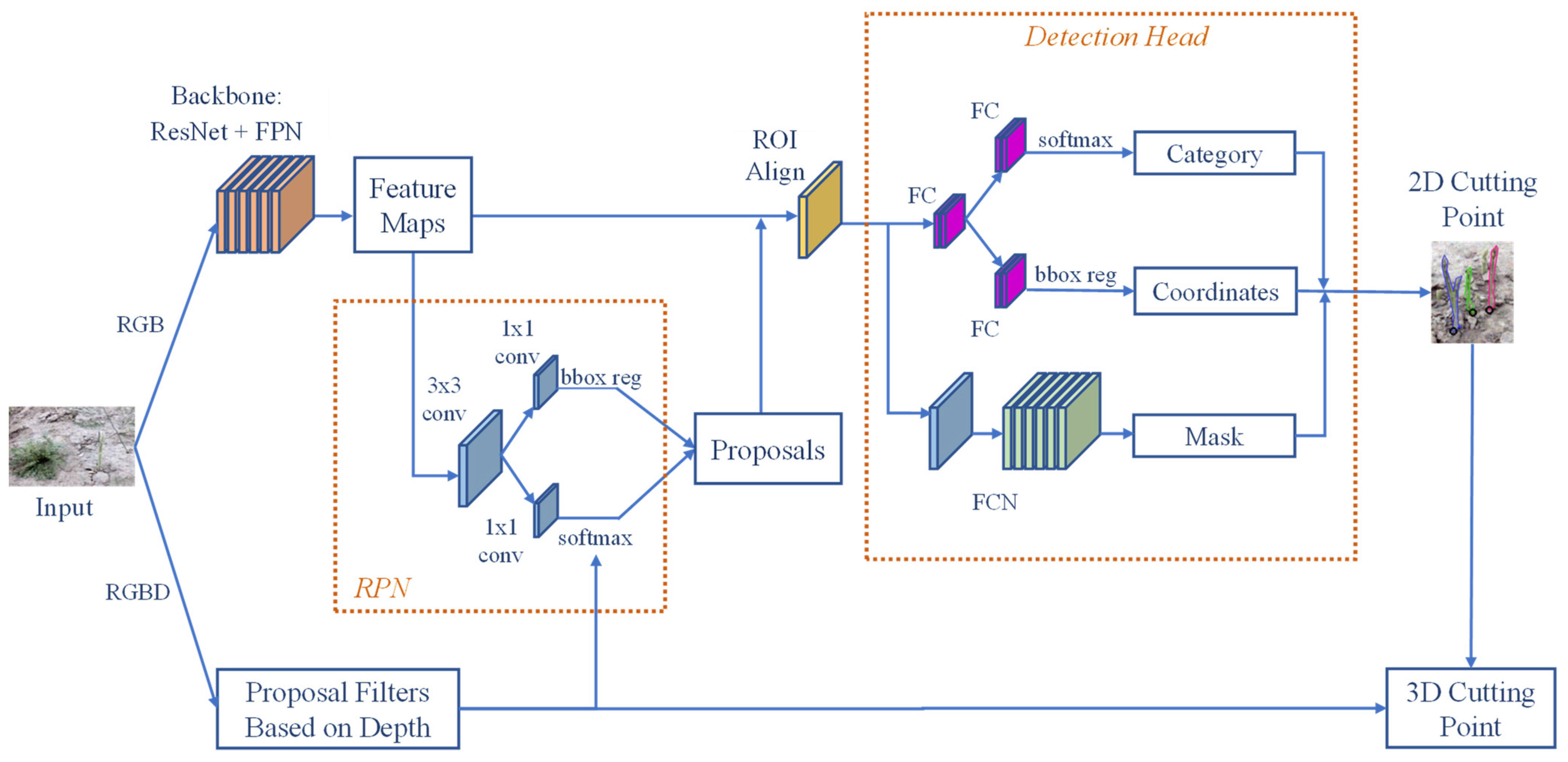
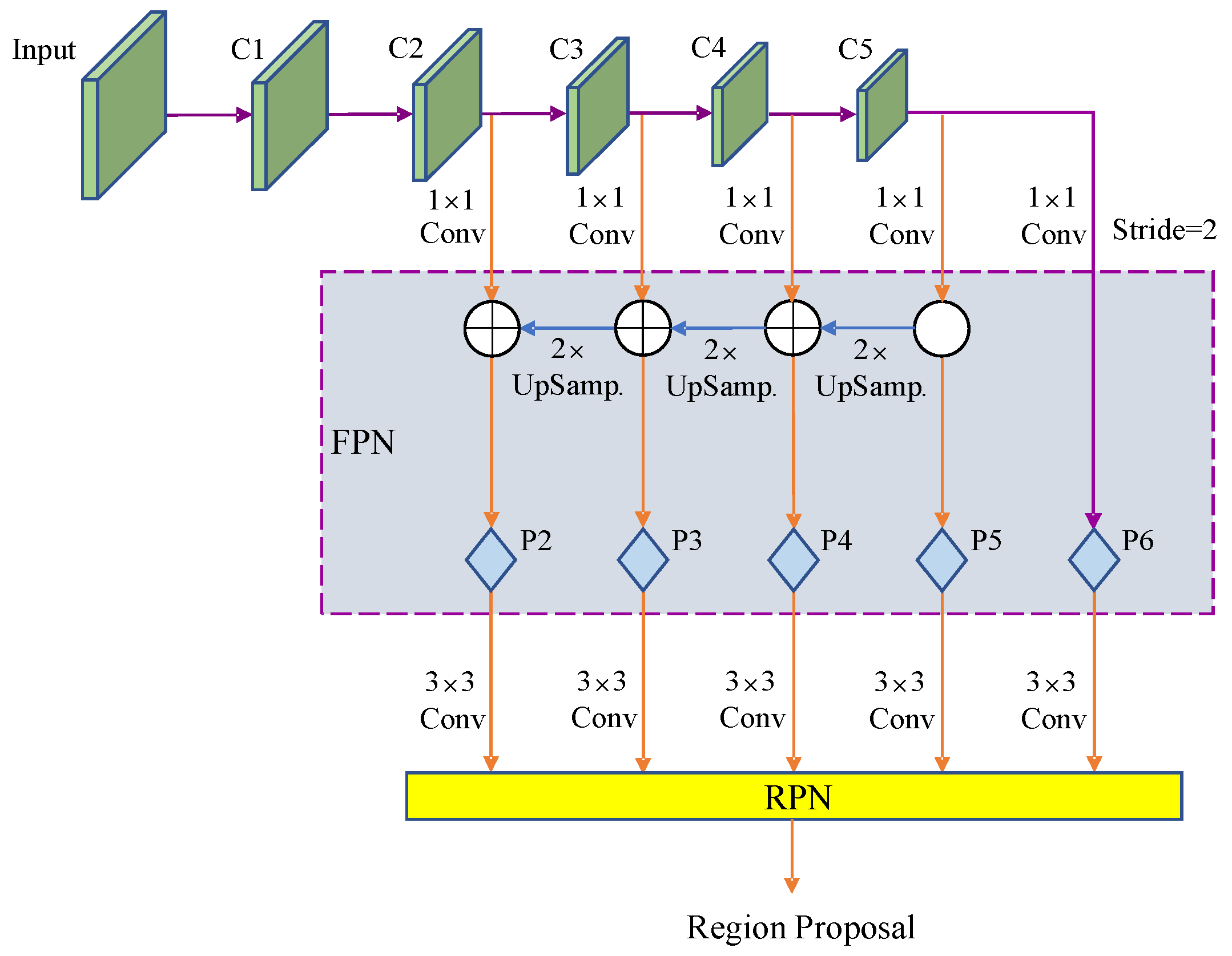

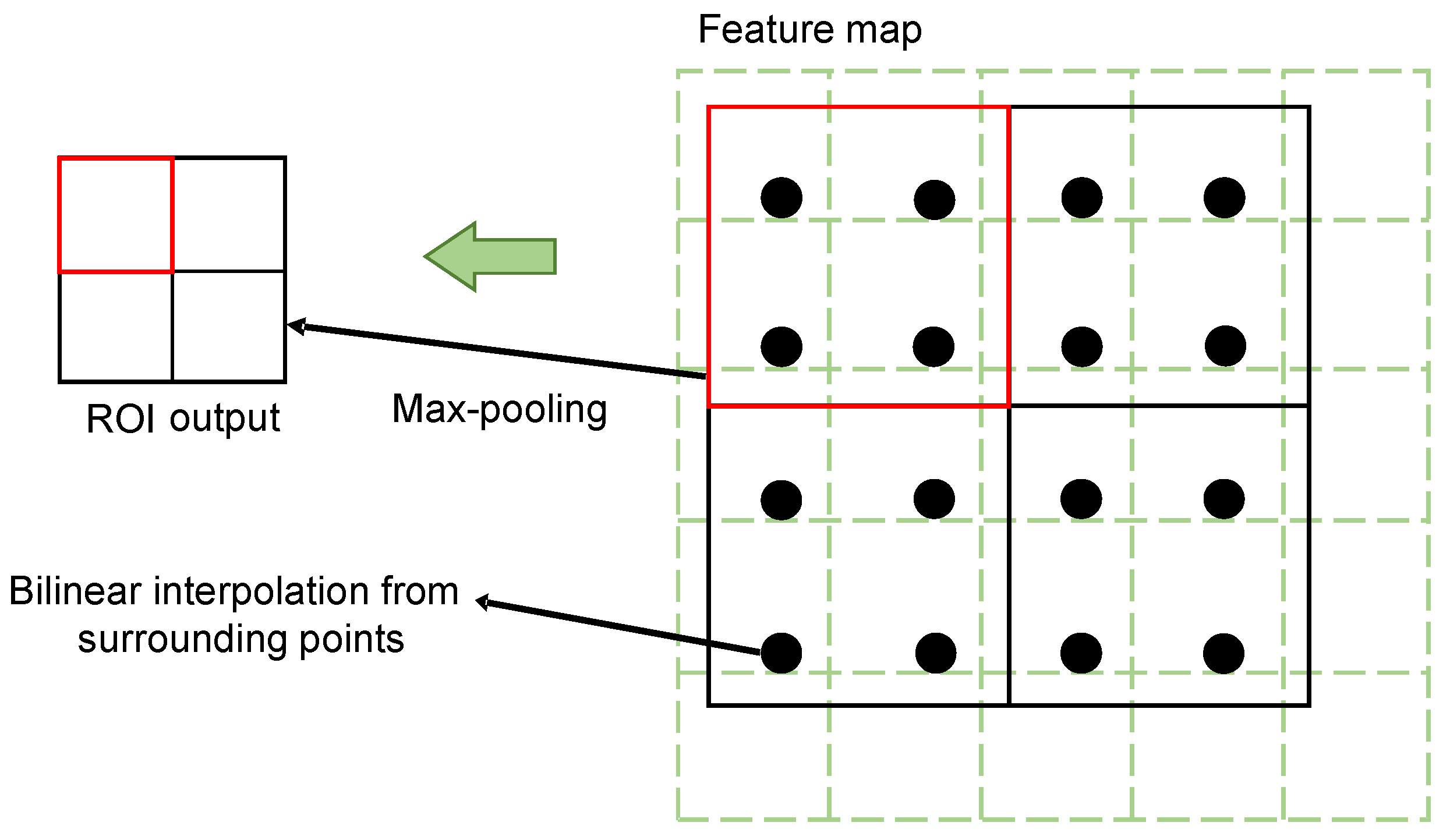
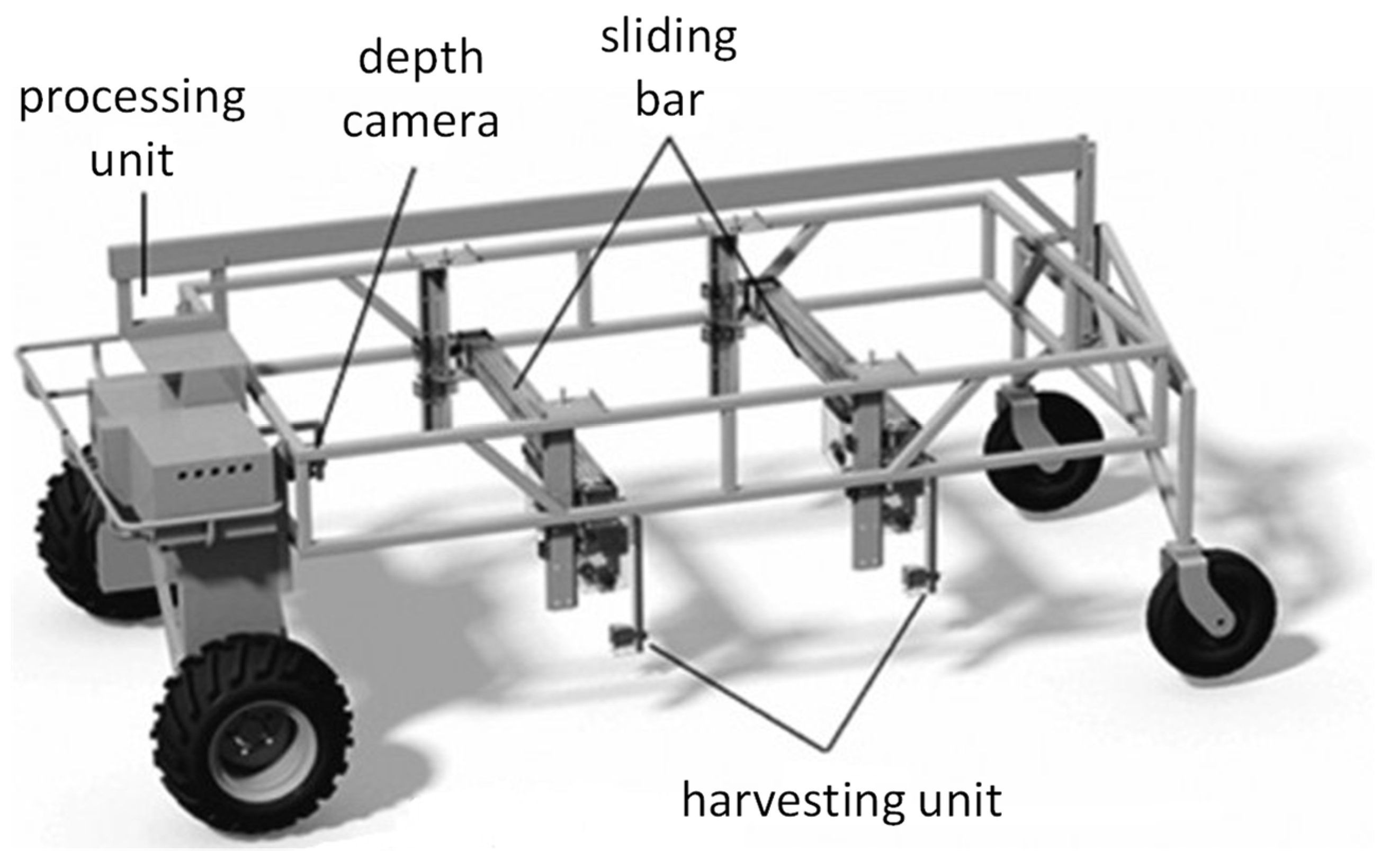



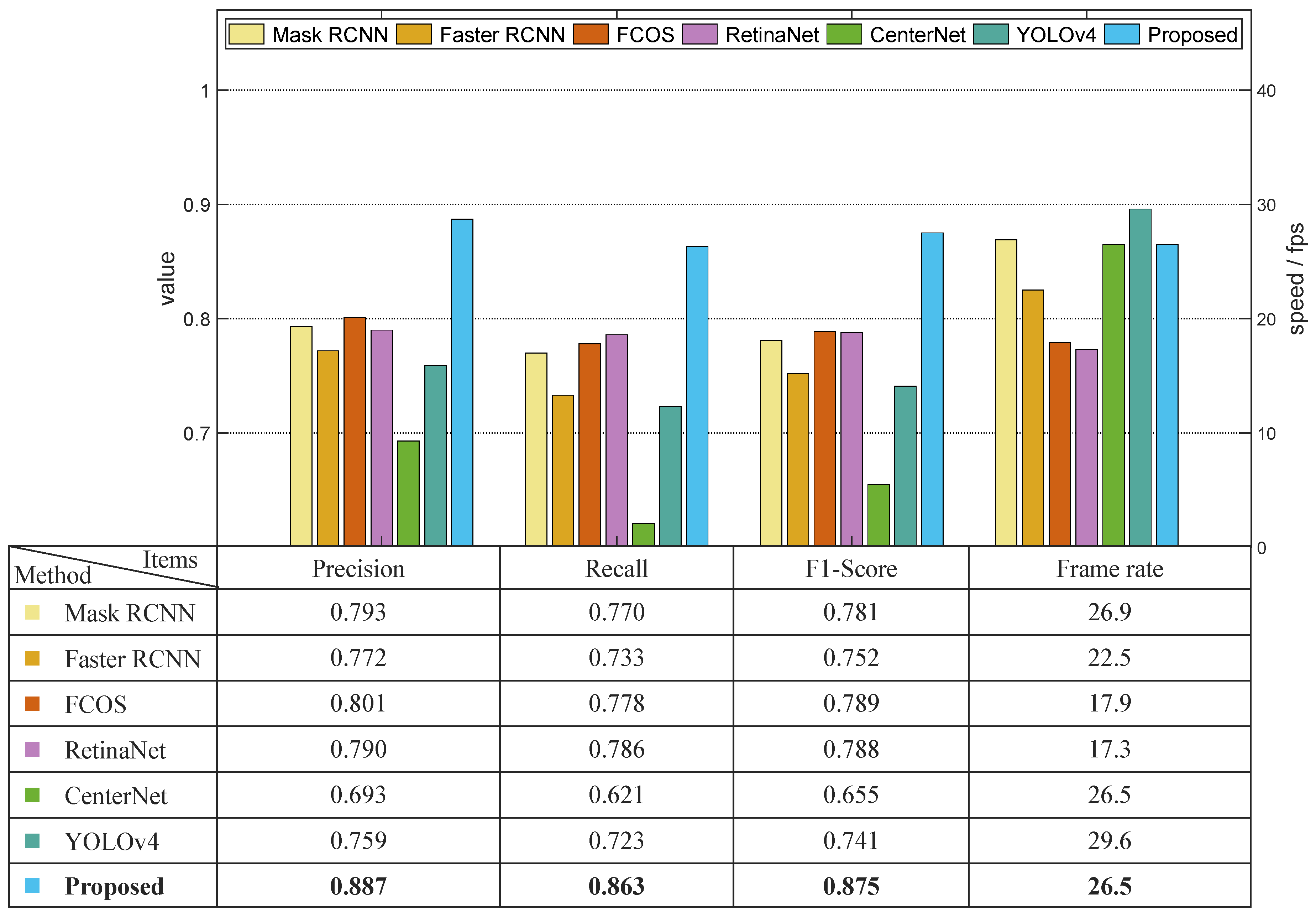

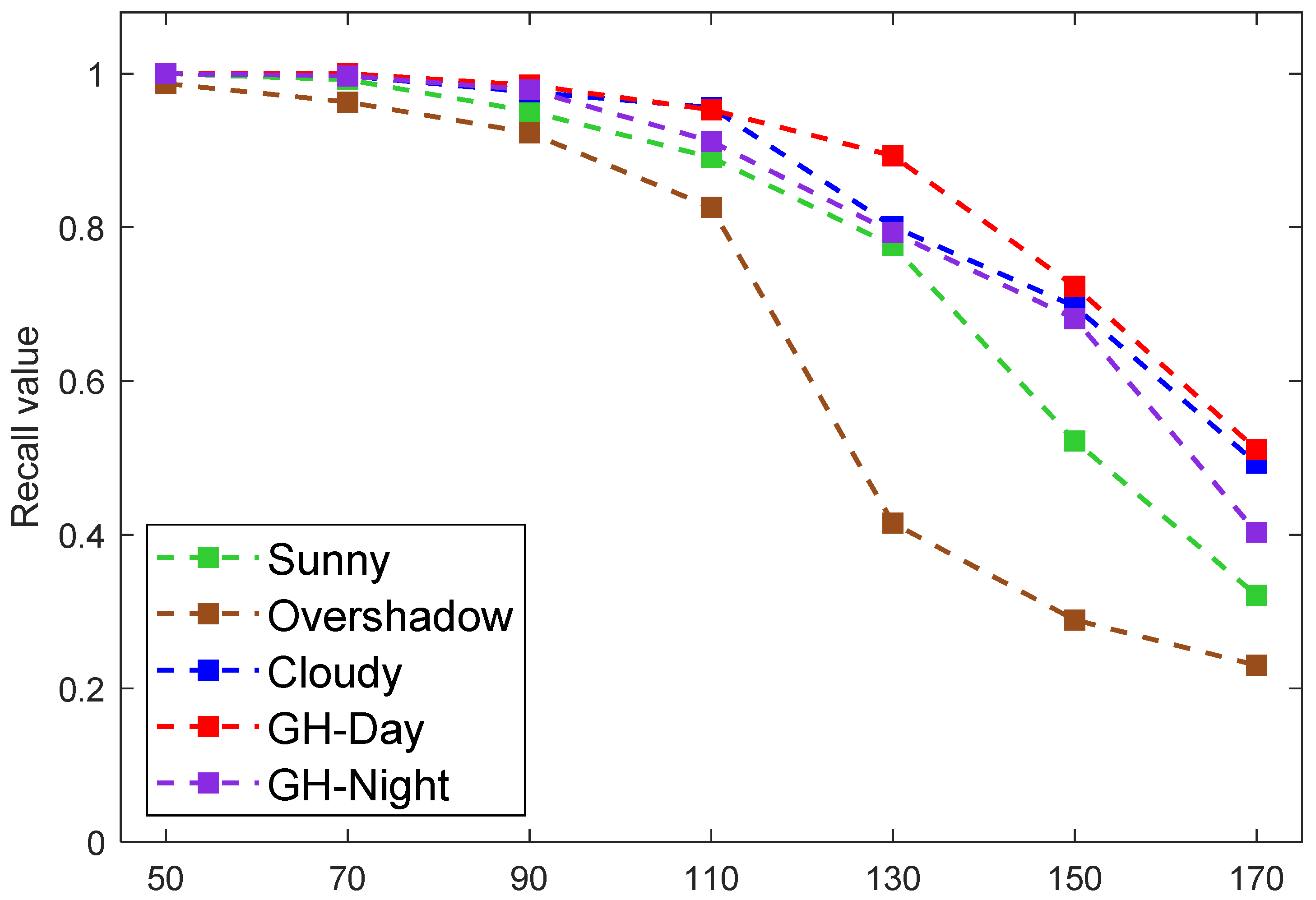


| Weather and Light Conditions | Precision | Recall | F1-Score |
|---|---|---|---|
| Sunny | 0.941 | 0.930 | 0.935 |
| Sunny but overshadowed | 0.887 | 0.863 | 0.875 |
| Cloudy | 0.952 | 0.950 | 0.951 |
| Greenhouse—daytime | 0.993 | 0.971 | 0.982 |
| Greenhouse—nighttime | 0.959 | 0.934 | 0.946 |
| Average | 0.946 | 0.930 | 0.938 |
| Weather and Light Conditions | No. of Targets | No. of Correctly Detected Targets | No. of Failed Targets | Correct Detection Rate/% | No. of Correct Location | Correct Location Rate of Cutting Point/% |
|---|---|---|---|---|---|---|
| Sunny (S) | 211 | 196 | 15 | 92.9 | 196 | 100.0 |
| Sunny but overshadow (O) | 206 | 178 | 28 | 86.4 | 178 | 100.0 |
| Cloudy (C) | 207 | 197 | 10 | 95.2 | 196 | 99.5 |
| Greenhouse—daytime (D) | 215 | 213 | 2 | 99.1 | 211 | 99.1 |
| Greenhouse—nighttime (N) | 203 | 190 | 13 | 93.6 | 190 | 100.0 |
| Average | 208.4 | 194.8 | 13.6 | 93.4 | 194.2 | 99.72 |
Publisher’s Note: MDPI stays neutral with regard to jurisdictional claims in published maps and institutional affiliations. |
© 2022 by the authors. Licensee MDPI, Basel, Switzerland. This article is an open access article distributed under the terms and conditions of the Creative Commons Attribution (CC BY) license (https://creativecommons.org/licenses/by/4.0/).
Share and Cite
Liu, X.; Wang, D.; Li, Y.; Guan, X.; Qin, C. Detection of Green Asparagus Using Improved Mask R-CNN for Automatic Harvesting. Sensors 2022, 22, 9270. https://doi.org/10.3390/s22239270
Liu X, Wang D, Li Y, Guan X, Qin C. Detection of Green Asparagus Using Improved Mask R-CNN for Automatic Harvesting. Sensors. 2022; 22(23):9270. https://doi.org/10.3390/s22239270
Chicago/Turabian StyleLiu, Xiangpeng, Danning Wang, Yani Li, Xiqiang Guan, and Chengjin Qin. 2022. "Detection of Green Asparagus Using Improved Mask R-CNN for Automatic Harvesting" Sensors 22, no. 23: 9270. https://doi.org/10.3390/s22239270
APA StyleLiu, X., Wang, D., Li, Y., Guan, X., & Qin, C. (2022). Detection of Green Asparagus Using Improved Mask R-CNN for Automatic Harvesting. Sensors, 22(23), 9270. https://doi.org/10.3390/s22239270







